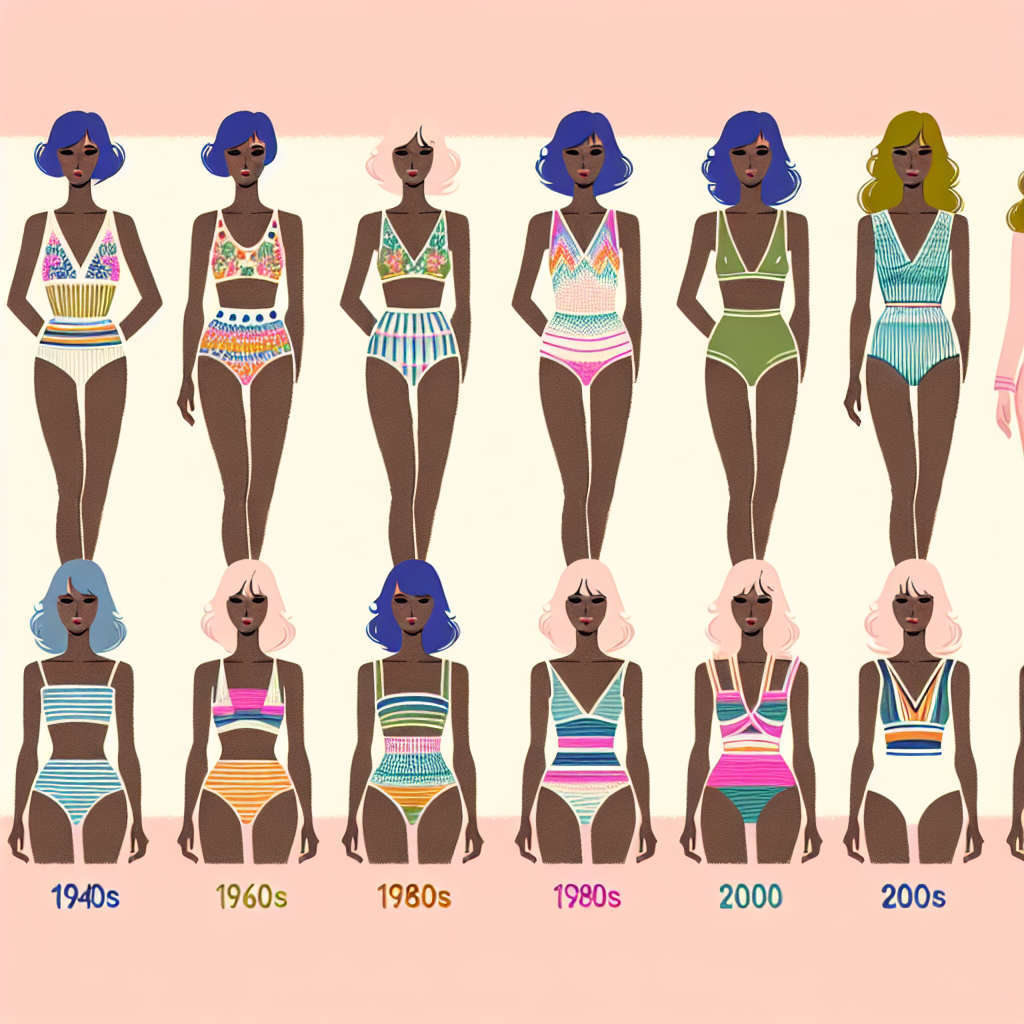Bikini styles have undergone significant transformations over the decades, influenced by cultural shifts, celebrity endorsements, and viral trends on social media platforms. Each era’s aesthetic reflects the societal norms and values regarding body image and femininity, making the bikini not just a swimwear choice but a powerful statement in fashion history.
In the 1940s, the bikini burst onto the scene thanks to French designer Louis Réard and actress Brigitte Bardot, whose famed appearance at the 1953 Cannes Film Festival catapulted the two-piece into mainstream acceptance. This early design featured minimal fabric, emphasizing the wearer’s curves and showcasing a bold, liberated attitude post-World War II. The bikini largely remained within this classic, modest framework, mostly celebrated through Hollywood glamour.
The 1960s introduced the micro bikini, a playful response to the sexual revolution. Designers began to experiment with cuts and patterns, bringing in floral prints and bright colors that mirrored the vibrant culture of the time. Enter iconic figures like Farrah Fawcett, whose influence in the 1970s propelled the bikini into a staple of pop culture, resulting in a variety of styles from string bikinis to high-waisted options that celebrated body diversity.
As we moved into the 1980s, the bikini evolved yet again due to shifts in fitness culture. The introduction of high-cut legs became synonymous with aerobics and fitness trends promoted by celebrities like Jane Fonda. This decade popularized athleticism as an appealing aesthetic, and neon colors became a vivid medium of self-expression. Innovations in materials, such as the introduction of Lycra, provided greater stretch and comfort, making bikinis more accessible.
With the advent of the internet in the late 1990s and early 2000s, the bikini underwent a resurgence in popularity through platforms like MySpace and early social media. The rise of influencers began to shape bikini fashion. The introduction of the “celebrity delicacy” bikini, where high-profile figures wore unique, often customized designs, created a new demand for exclusive brands and styles. Bikinis with embellishments, ruffles, and even quirky cuts became all the rage.
The 2010s saw the birth of the body positivity movement, significantly impacting bikini design. Brands began to cater to diverse body shapes and sizes, introducing options like plus-size fits and more inclusive marketing strategies. The virality of trends shifted toward platform sharing, such as Instagram and TikTok, where hashtags like #BikiniBody and #SwimwearGoals inspired millions to showcase their unique styles. Seasonal trends featured eco-friendly materials, with sustainable fashion leading the charge.
Emerging alongside these movements was the popularity of the “high-waisted bikini.” This retro-inspired style gained traction on social media, appealing to those who preferred a vintage look while remaining fashionable. Key influencers further promoted this trend, showcasing how this style accommodates various body types, blending comfort and elegance effortlessly.
Fast forward to 2020 and beyond, the modern bikini landscape is shaped by viral TikTok challenges that often highlight specific trends and styles. Influencers feature hook-and-eye bikinis, crochet designs, and more experimental materials. The boundaries of bikini fashion continue to expand, with mesh overlays and asymmetrical cuts trending heavily. This new wave draws inspiration from cultural and geographical diversity, showcasing swimwear from different regions, such as Brazilian lace styles and African prints.
The advent of technology has played a pivotal role in shaping bikini trends. Virtual reality and augmented reality allow consumers to experience bikinis through immersive fitting rooms, revolutionizing the shopping experience. Moreover, brands leverage data analytics that track popular searches and engagement to predict emerging trends. This responsive approach ensures that Bikini styles stay relevant and fashionable, catering to Generation Z and millennials who prioritize authenticity and inclusivity.
Additionally, the return of the minimalistic bikini, often dubbed the “internal bikini,” emphasizes sustainability and clean-cut designs with less waste. By embracing simple silhouettes and limited fabric, the eco-conscious yet chic trend reflects a growing concern for environmental impact within the fashion industry.
As we examine the evolution of bikini styles through viral trends, it’s essential to recognize that each change represents broader cultural dialogues influencing self-expression, identity, and body positivity. The bikini continues to serve as a canvas for individual creativity, ensuring its status as a timeless garment amidst an ever-changing fashion landscape. From vintage glamour to innovative designs, each bikini tells a story, making it an enduring symbol of personal style and empowerment.



